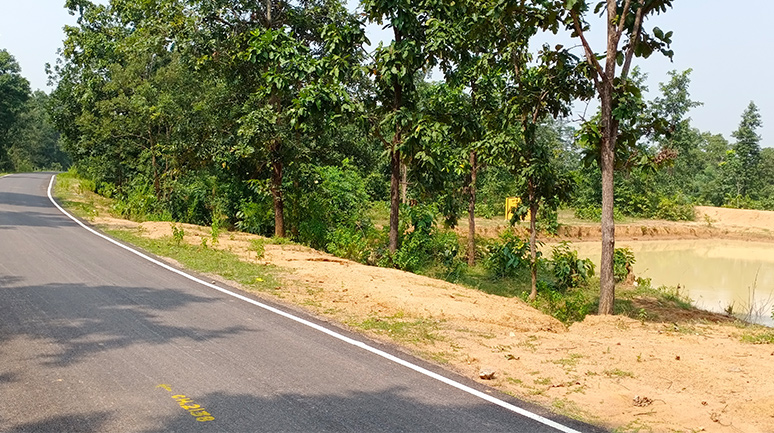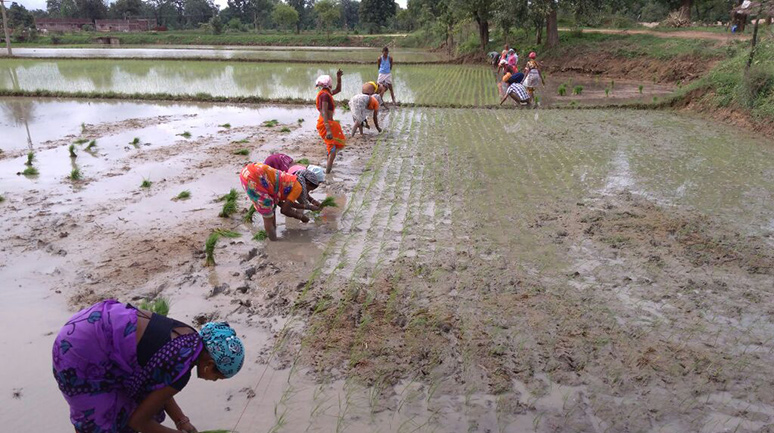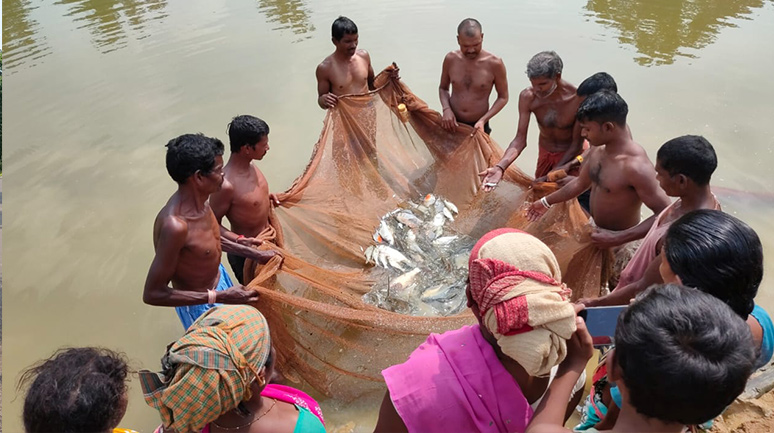Changing Lives and Livelihoods

Supporting the villagers with technical know-how, introducing them to new ways of conserving the more-than-adequate rainwater each year, tying up with government agencies and programmes not only led to alleviating poverty and malnutrition but also gave the village women the confidence to take on leadership positions in local bodies.

The road to Kishanpuri village skirting a farm pond. Many such farm ponds are visible as one moves towards the village.
Lush green fields dotted generously with a number of water ponds are the first thing that one notices when one enters Kishanpuri, a village in Kanker district in Chhattisgarh. This picturesque place is very different from the sun-baked barren lands that the village was some five years back.
When PRADAN started working in Kishanpuri in 2009, it was an arduous task to mobilize the people of the village into self-help groups (SHGs). Half the families of the village were tribal (ST) families and half belonged to Other backward castes (OBC), with a few Schedule Caste (SC) families on the fringes. After much persistence and persuasion, two defunct SHGs were revived and two new SHGs were formed in the village by PRADAN; however, there was little interaction among the communities. Slowly, PRADAN started working with the SHGs and provided training in improved farming practices such as in the system of rice intensification (SRI) and trellis farming. However, these activities were inadequate and much more needed to be done to lift the village from backwardness and poverty.
Many of the farmers were dependent on the monsoon for irrigation. Although the villagers of Kishanpuri owned 2–2.5 acres of land on an average, the area of cultivable land was much less. There were no natural streams. The village receives 1200–1400 mm of rainfall per year and much of this water, sadly, flowed away as runoff. Rainfall is very erratic; sometimes, continuing dry spells affected standing crops. Some farmers, who could afford to, had dug borewells in their farms. This eventually became a major point of contention between the people of the village because the level of the ground water started receding. “Earlier, we used to get water at about 30–40 ft; with increasing bore wells in the area, however, we do not find water even at 200–or 250 ft,” says Ombati Bai, an SHG member. The only solution to the problem was to harvest and conserve rainwater. However, the villagers were not convinced.
Only 12 farmers agreed to have ponds constructed in their fields. They selected areas that were totally barren and of no use. In one year, these 12 farm ponds were constructed in a series. The results of this intervention became evident within a year, with farmers cultivating maize the next year with water from these farm ponds.
In 2014, with the intervention of State Rural Livelihoods Mission (BIHAN), 10 more SHGs were formed in the village and, as per the guidelines, a village organisation (VO) was also formed. In the same year, an initiative of the government, called the MGNREGS-Cluster facilitation team (CFT) convergence project was introduced. The MGNREGS-CFT convergence project was a three-year pilot project of Ministry of Rural Development (MoRD) in 2014, to enhance rural livelihoods through MGNREGA in 250 backward blocks of India.
PRADAN in Narharpur was also the CFT implementing partner with MGNREGA. The whole program was based on integrated natural resource management (INRM) planning, labour mobilization under MGNREGA and increasing the job participation of the ST and SC communities.
At the time of forming the CFTs, PRADAN organized a planning event, supported by the MGNREGA cell and the gram panchayat (GP). The participation of the villagers, unfortunately, was very poor. No one was ready to construct a farm pond or any other water storage structure on their land. Only 12 farmers agreed to have ponds constructed in their fields. They selected areas that were totally barren and of no use. In one year, these 12 farm ponds were constructed in a series. The results of this intervention became evident within a year, with farmers cultivating maize the next year with water from these farm ponds.
At the same time, MoRD initiated the Integrated Participatory Planning Exercise (IPPE), a national initiative to involve all the villagers in the MGNREGA planning process. The basic idea of this initiative was that the villagers should plan their own village development and that it must be a holistic development plan. Under the IPPE, gram sabhas (village meetings) were called in every village, to develop a plan. In Kishanpuri, however, only 4 or 5 people were present in the initial meeting; no woman was part of the initial gram sabha.
“We discussed this non-participation of women in the gram sabha with VO members. Initially, they were very reluctant to voice their thoughts. Some said that planning was not a woman’s work. Some said that they would ask their family members to be part of it. However, some wanted to be part of the gram sabha and the village planning process. Discussions were also held as to why it is important for all the villagers to participate in MGNREGA planning and that each person’s views be considered. We were aware that the VO provided us the platform to meet people from different communities; we wanted to use this opportunity and influence all the families to come together for a village-level planning,” said Nitu Lonhare, a VO member.

Women transplanting paddy. A series of farm ponds are constructed in the upstream to hold the run off water.
This was a herculean task for women SHG members. They slowly convinced their family members and the entire village to participate in the planning meetings. People from different communities kept aside their differences and came together for the village-level meeting.
In the gram sabha, in which representatives from Panchayat Raj Institutions (PRI), the MGNREGA cell and PRADAN were present, many issues were discussed such as the water storage capacity of ponds, technical issues, work measurement and another planning event. The main fear of the villagers was what would happen if the ponds did not retain water? They would lose their land. The MGNREGA staff, the PRI functionaries and the farmers, who had seen the change in their land, shared their experiences in the meeting. This influenced the other villagers into believing that they needed to make many more structures like the farm ponds so that the water table could be recharged, thereby helping them during drought also.
During the gram sabha, villagers heard about the success stories of the other villages, where the participatory planning process had helped in water harvesting and land development, leading to increased income round the year. The villagers agreed to develop 50 farm ponds in series along with other works such as land levelling, 30*40 model and trenches in their own lands to harvest water. The plans were approved of in the gram sabha.
In November 2015–16, work started and villagers got jobs in their own land. People were excited to do this work because not only were they making something on their own property that would help them in irrigation, they were also earning money under MGNREGA. The process instilled confidence in the villagers. The GP acknowledged the efforts of the VO.
The CFT and IPPE programmes were pivotal in making villagers aware of their own capacity to think about development and make it a reality. This was the phase when the SHG members initiated the process of taking part in the decision-making process in their homes as well as in the GP. In the third year of planning, the SHGs took on the responsibility of making the INRM plans themselves and implementing these too. Women organized meetings and also submitted plans for INRM work required in their land. PRADAN organized technical training for the women’s groups and gave them an exposure to what happens at the field level so that the women could understand the INRM concept. MGNREGA/INRM plans and work were part of the agenda of every VO meeting held each month. In the initial three years of engagement, the GP was able to mobilize Rs 1.33 crores under MGNREGA, with the support of the VO. Kishanpuri VO now leads the whole process of implementation by mentoring the field execution of work. The VO made committees of 5 VO representatives, who visit the work site and monitor the quality of work being implemented. They also discuss the shortfalls with the GP and their VO. From 2014–18, a total number of 84 farm ponds were constructed as a result of the initiative taken by the women’s group.

With water available in the farm ponds, pisciculture has emerged as a new livelihood opportunity for the farmers of Kishanpuri.
In 2018–19, a programme called High Impact Mega Watershed Project was initiated by Bharat Rural Livelihood Forum (BRLF), Axis Bank Foundation (ABF), PRADAN and the Chhattisgarh government. Under the Mega Watershed Project, a detailed INRM-based watershed planning was done in Kishanpuri. PRADAN has been engaged with the women collectives since 2009 around improved agriculture practices, and rights and entitlement under MGNREGA. These women’s collectives again took the lead in the process.
| MGNREGA Work Details in Kishanpuri GP | |||||
| Particulars | FY 2015–16 | FY 2016–17 | FY 2017–18 | FY 2018–19 | FY 2019–20 |
|---|---|---|---|---|---|
| Average days of employment provided per Household (HH) | 116.32 | 96.77 | 119.42 | 137.36 | 102.07 |
| Total no. of HHs completing 100 days of wage employment | 181 | 151 | 193 | 258 | 168 |
| INRM expenditure (Rs in lakhs) | 46.79 | 35.84 | 59.42 | 68.82 | 51.45 |
| Total expenditure (Rs in lakhs) | 49.59 | 61.69 | 69.27 | 72.87 | 60.74 |
An intensive 5-day planning of INRM on the watershed approach was conducted in Kishanpuri in January 2019. The plan was developed through a participatory approach. Around 84 farm ponds, 155 land development works, loose boulder structures, plantation and gabion-like structures have been planned in the community as well as private land. Fourteen farm ponds, costing Rs 39 lakhs, were completed and 20 acres of land were treated in 2019–20.
Because of the efforts of the women’s groups, 105 farm ponds have been constructed in the village, using MGNREGA funds. This has brought about a huge increase in the net sown area from 304 to 360 ha. The productivity of paddy has also increased; farmers who harvested 6–8 quintals per acre of paddy earlier due to lack of irrigation were now harvesting 12–14 quintals per acre, thanks to a regular supply of water from these farm ponds. Some families have harvested up to 20 quintals of paddy through the SRI method. Earlier, the main crop was only paddy due to the limited availability of water; now, however,
| Construction in Kishanpuri under MGNREGA | |
| Structure | Number |
| Farm pond | 105 |
| Community pond | 6 |
| Land development work | 55 |
| LBS | 7 |
| Dug well | 3 |
the villagers use the water from the farm ponds to cultivate vegetables such as brinjal, cow pea, pulses and cauliflower in winter and finger millet, maize and black gram, adding to their annual income. Many farmers found that the bore wells that usually dried up in October or November had water till March and April. Currently, 45 families have adopted fish farming as a livelihood activity in their community as well as in their own farm ponds; this activity has added Rs 15–20,000 annual income for them. Fifty-five families have benefited from the land development work. Twenty-six acres of barren land is now cultivable; the villagers grow paddy and vegetables in that land now. This is the beginning of the change.
In last five years, under MGNREGA, Rs 3.14 crores was disbursed in this GP, of which Rs 2.62 crores was for INRM work. On an average, in the last 5 years, 190 families have got at least 100 days of employment under MGNREGA. The average days of employment provided per HH is 114 days. Due to the planning activities and their implementation, each family working under MGNRGA gets an average of Rs 15–20,000 per year.
This movement has given the SHG members a huge confidence. These activities and processes not only changed the livelihoods scenario but also saw the representation of women in GPs. In 2019, for the GP elections, the women put up VO members as candidates; with support of the members, Satyawati Netam, an SHG member has been elected as Sarpanch (head of the panchayat). Along with Satyawati, eight other women have also been elected as panches (members of the panchayat). There are now eight women panches in the GP. This is the result of the unity of women in the village. “I never dreamed that I would stand for elections for the position of the Sarpanch; all the SHG members, VO members and the siyan (elders)of the village motivated me and gave me confidence during the whole electoral process. I was elected because of the support of the whole community, especially the women of our village,” says Satyawati Netam, Sarpanch, Kishanpuri GP.


2 Comments
Great. Just reflect back the day of high conflict in GramSabha in Kishanpuri on 2014. Really a story of transition. Must thanks Kumari didi, Rakesh, Omdidi, Kawardhadidi , Amit, Jageswar , Sanjay , Kushal Bhaiya and all didi’s and Bhaiyas of this GP. Feel fortunate to be with you, Sandeep Bharmoriya, Hemant( the author) and full PRADAN and Bihan, Mgnregateam from 2014 for somedays as a catalyst of this developmental journey. Must thanks BMMU, DMMU Bihan, Mgnrega cell block and district for join hand with community in this journey.
Yes Kuntal, each and every stakeholder gave their full effort to make it happen. Still together we have many miles to go. Didis have planned for many other structures to save more water.